

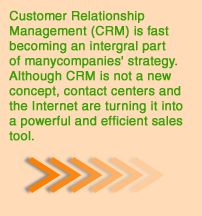 |
  |
..............................................................................................................................................................................................................................................
| centers is set tobecome a truly mammoth industry as the new century unfolds. Thelogic behind this is simple. Customer Relationship Management (CRM) is now considered to be the pivotal starting point for survival in today's dog-eat-dog business environment. And while a contact center may not be the only weapon in the CRM armory, effectively used, it is one of the most potent. The U.S. continues to pioneer development in contact center CRM. Frost & Sullivan estimates that combined revenues for the U.S. contact center service industry were $19.9 billion in 1998 and these will recket to $49.45 billion by the year 2005. But if the U.S. is presently the number one player in the international contact center industry, the rest of the world is catching on fast to the importance of this customer contact channel. According to Dataquest market research, by 2002 there will be more people working in contact centers in the U.K. than there will be people working in the farming and teaching sectors combined. |
Contact centers grew to prominenec in tandem with the introduction of intelligent network-based freephone services in North America in the late 1980s. Originally contact centers represented a relatively simple proposition : customers and would-be customers dialed in for help and were hooked up with agents with access to information about their queries, status or potential needs. The technology providing this was, and is, called computer telephony integration (CTI). As the name implies, CTI involves the physical or logical interfacing of voice communication and data access capabilities. Subsequent refinements have significantly extended the contact center repertoier. For example : integrated voice response (IVR), in which callers respond with keystrodes to voice prompts to navigate their way to an appropriate agent or information repository, and speech recognition, in which systems guide users to different destinationson the basic of the caller's spoden responses. ------------------------------------------------------------------------------------------------------------------ |
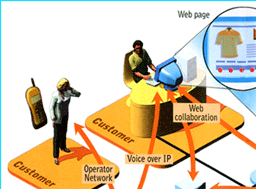 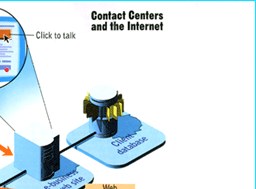 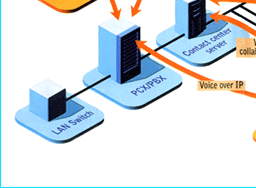 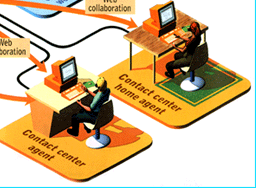 |
Increased Functionality As the technical sophistication of contact centers has increased, so has their functionality. Originally used to provide information or take orders, contact centers can now be used to expand an organization's share of profitable customers, help less profitable customers become more profitable, and cross - sell related products.Customer retention and reduction of customer churn are key contact center objectives. SLP, a specialist in the application of knowledge-based technologies to boost customer retention programs, has some interesting statistics in this general context. SLP calculates that in the telecom industry, for example, annual customer churn rates average 30% in European markets, 40% in the U.S., and 50% in some Asian markets. In 1998, says SLP, |
||||
| the global cost of telecom customer
defections was $10 billion. The cost of acquiring a new subscriber ranges from $400 in the U.S. to as much as $700 in Europe.If the penalties for poor or non-existent CRM can be high, the nature of the CRM task in contact center terms is becoming much more complex. As well as incoming and outgoing voice traffic, contact centers now have to deal with fax calls, e-mail and, increasingly, web and Internet calls. The changeover from voice-centric contact center operation to contact centers that mix e-mail and web traffic is a complex task. Instead of simply providing agents with the means to talk to callers and to access and manipulate relevant customer data, contact centers systems now have to support an extended repertoire of customer - facing applications. Among them are e-mail response, simultaneous voice and data interactivity, text "chatting", collaborative browsing and form sharing. |
|
||||
|
What's more, companies must not only offer these new and emerging customer communication channels, but they also must integrath them to provide a consistent level of service across all media types. For example, if a customer sends an e-mail message on Monday and follows up with a phone call on Wednesday, unless the agent taking the call has knowledge of the information contained in the initial e-mail, the customer may feel frustrated by the need to repeat the inquiry. They may even defect to a competitor with superior customer care. More services For e-mails, the agent must respond in the same manner as when dealing with conventional voice calls, although the response time may be somewhat less critical. Today's contact center systems can either automatically respond to routine e-mail inquiries, or suggest responses to agents based on parameters and thresholds set up in advance by contact center management. |
|||
 In the case of Internet-related calls, the idea is that a customer or would-be customer could be browsing a corporate web site. When the person requires more information on a particular product or service, s/he simply clicks on an icon rather than calling up an agent in the conventional way. There are a number of service permutations in this case. The voice conversation with the agent could be counducted as a voice over IP (VoIP) session using the existing Internet connection to the corporate web site. Both the caller and the agent can then exchange and browse the web pages they can see in their respective browser windows. For callers without VoIP access but with access to lines - say in the case of an ISDN subscriber - one line can be used for voice, the other for the data traffic. Where callers have only one line, automatic When a customer or would - be call-back from the appropriate contact center agent can be set up at a time convenient to the customer requires more information caller. s/he simply clicks on an icon rather than calling up an agent in the ........................................................................................ conventional way. |
||||
|
Text chatting - the exchange of text in real time between the caller and the agent - may also be requirement, parrticularly where the quality of VoIP is not acceptable or where there is a need to be precise about numbers or name spellings and so on. Increased Business Customers may also require assistance with form filling and, again, screens may need to be exchanged so that both parties see the same document and changes as they are made. It could be argued that the emergence of the web as a self-service medium actually narrows the window of opportunity for contact centers. Not so, according to an Ovum study. In a 1999 report entitled Next Generation Call Centers : CTI, Voice and the Web, Ovum agrued : " Call centers are where businesses talk directly to their customers, discovering their requirements, persuading them to do business, and ensuring their demands are satisfied. Call centers also have a crucial advantage over self - service media - they allow businesses to be proactive in ways that would be rejected or ignored if self-service media were used," |
  |
However, Ovum warns user organizations that they must be clear on their business strategies. "users must decide whether they are webenabling their call centers of call centerenabling their web sites. The end result may appear the same, but the two are different. The difference is apparent when used organizations decide what it is they want to achieve and then measure what it is they have achieved." Ovum points out that when user organizations web - enable their contact centers, they are typically either using the web as a "front door" to the contact center or are using the web to enhance the effectiveness of contact center interactions. When user organizations contact center-enable the web,they are typically either increasing the success rate of web transactions or providing a back-up for problems that cannot be resolved via the web. |
|
| COMBINED REVENUES | CUSTOMER ACQUISITION |
Either way, though, the combination of the contact center and the web acts as a
powerful catalyst tor e-commerce, offering
intraction possibilities above and beyond
the information available on a website. Currently,
many web-only e-commerce
transactions are abandoned before completion
and there is strong evidence that interaction
with a human agent can be
instrumental in turning web window shoppers into buyers.
For the future, industry
experts see the contact center industry developing in a number of new directions.The type of traffic
handled will expand to include video,
and customers using cell phones will become a bigger consideration in
contact center
operations. Web-enabled cell phone use also
is expected to rise, opening yet another channel
for customer care and
e-commerece transactions. The part played
by outsourced contact center services will increase.
Ultimately,some contact
centers will become "virtual" with agents handling calls from anywhere rather than from one
physical location.
  ........................................................................................................................................................... |
More
information, please contact E-mail
: chatchai@ckmit.com